Hi-Fi (1965-77)
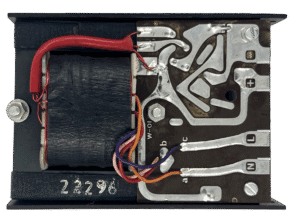
This compact power unit was the hidden engine behind Sinclair’s early hi-fi systems, providing clean, stable power to modular amplifiers like the Z12 and Z30. Sinclair advertised the PZ3 as having “barely measurable” electrical noise—just 0.05 volts—helping to avoid hum and interference in audio playback. Introduced during the rise of the 1960s hi-fi craze, the PZ3 supported a new generation of slim, solid-state equipment that was cheaper and easier to assemble at home.
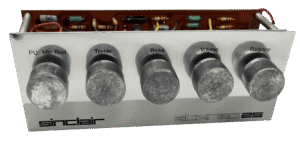
This was Sinclair’s first dedicated hi-fi control unit and marked a shift from DIY kits to ready-built modules. Designed by his bother Iain Sinclair, it offered volume, balance, and tone controls and was used alongside the Z12 amplifier and PZ3 power supply. Supplied pre-assembled but uncased, it let users build a custom stereo setup at home. Production stopped in 1968 after its supply of bargain-priced transistors ran out, but the unit laid the groundwork for Sinclair’s later Project 60 success.

The Q14 was Sinclair’s first loudspeaker, designed to complete the company’s earliest home stereo system. Sold by mail order alongside the Z12 amplifier, it marked a step toward affordable, modular hi-fi for enthusiasts. Its elliptical speaker and fibreboard cabinet aimed to balance clarity with comfort—making it suitable for long listening sessions in everyday home settings.
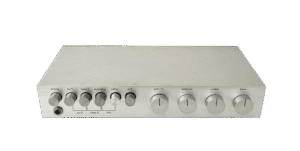
This modular, clean-lined aluminium-cased amplifier formed the heart of Sinclair’s first mainstream, dealer-available hi-fi package. Designed by Clive and Iain Sinclair, it paired neatly with a matching tuner and distinctive circular speakers. It was marketed as delivering 35 watts of stereo sound with wide frequency response and low distortion—balancing performance with affordability. Built using germanium transistors, commonly found in 1960s audio equipment, it was later revised in 1970 to improve performance and reliability.
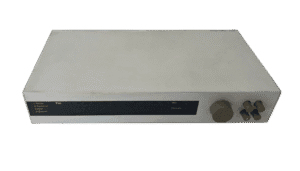
Part of the modular System 2000 hi-fi range, this FM tuner used pulse-counting discrimination—a departure from the more commonly used coil-based circuits found in most tuners of the time. This offered lower distortion and, combined with printed circuit construction, made manufacturing simpler and more consistent. In late 1968, Sinclair added a small plug-in stereo-decoder module. However, precise alignment and frequency drift limited its success. Redesign efforts began around 1970, and in 1972 the range was eventually replaced by the improved System 3000.

This compact pre-amp was the control hub of the modular Project 60 hi-fi system—one of the company’s most commercially successful audio lines. It replaced the earlier Stereo 25, improved reliability with a silicon-transistor design. Sold in kit form with a 48-page manual, it invited users to build their own setups, capable of adjusting volume, tone, and balance. It could be paired with either the Z30 or Z50 power amplifiers and was promoted as Europe’s best-selling modular hi-fi system.
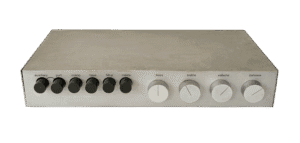
This updated model refined the original System 2000 amplifier with improved reliability and simplified circuitry. It retained the aluminium case and maintained the previously promoted 35-watt stereo output, but replaced the earlier germanium transistors—less stable and more sensitive to temperature—with more robust silicon components, now mounted directly on the main circuit board. The redesign reflected Sinclair’s ongoing effort to improve quality while preserving the modular, modern look of the range.
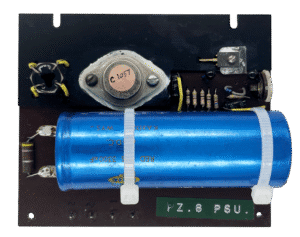
Designed to support Sinclair’s Project 60 hi-fi systems, the PZ8 Mk 2 delivered up to 50 volts of stabilised DC power. Its standout feature was a self-resetting current limiter—an uncommon safeguard in hobbyist electronics of the time. Intended for use with a separate mains transformer, the unit handled high voltages while protecting connected equipment from overloads and short circuits. It reflected the growing attention to safety and reliability in the modular home audio designs of the time.
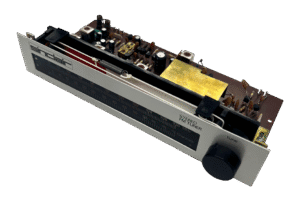
This FM tuner brought stereo radio to the modular Project 60 system. It covered standard FM broadcast frequencies and included features such as automatic tuning and stereo signal decoding. Sold in kit form, it was often paired with the Stereo Sixty pre-amp and other modules, allowing users to build a personalised hi-fi setup at home at a lower cost than most comparable alternatives.
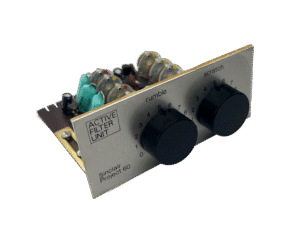
Designed to reduce rumble and surface noise, this stereo filter connected between the pre-amp and power amplifier in Sinclair’s modular Project 60 system. It offered adjustable high- and low-frequency cut-offs, helping users fine-tune their audio output. Like other Project 60 modules, it was sold as a kit for home assembly and could be installed in custom enclosures—such as cabinets or plinths—giving users flexibility to tailor their setups to fit their space and preferences.
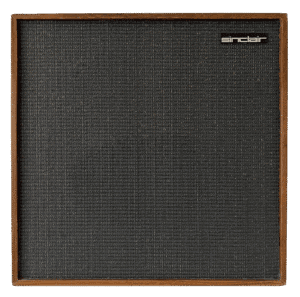
A stylish bookshelf loudspeaker designed for Sinclair’s modular Project 60 range, the Q16 aimed to bring high-fidelity sound to a wider audience. It featured an 8-ohm impedance, 14-watt RMS rating, and a frequency range of 60 to 16,000 Hz—specifications typical of compact home speakers of the time. Its solid teak surround and all-over black cellular foam front reflected the aesthetic tastes of the period, designed to complement modern interiors as well as deliver sound. It replaced the earlier Q14 speakers and remained on sale until 1972.
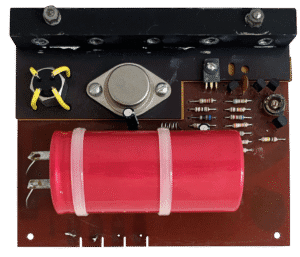
This improved version of the PZ8 Mk 2 introduced a re-entrant current limiter that reset automatically after a fault—an advanced safety feature for its time. Used both before and during the early years of Project 80, it also powered Project 60 hi-fi units, including the Z50 Mk 2 amplifier. Designed for low electrical noise and stable output, it appealed to technically minded users building or customising home audio systems.
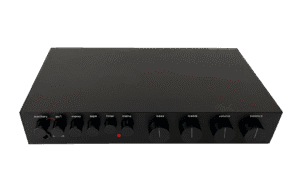
This stereo amplifier was promoted as delivering 11 watts per channel with just 0.04% total harmonic distortion—specifications that suggested clear, high-fidelity (hi-fi) sound, meaning audio that stayed close to the original recording. It featured a fully regulated power supply and built-in overload protection to help maintain consistent output, even under demanding use. Designed as the centrepiece of the System 3000 range, it reflected a shift toward more robust and user-friendly hi-fi design in the early 1970s.
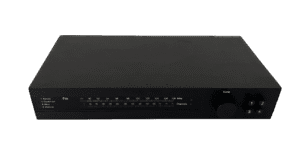
This improved version of the PZ8 Mk 2 introduced a re-entrant current limiter that reset automatically after a fault—an advanced safety feature for its time. Used both before and during the early years of Project 80, it also powered Project 60 hi-fi units, including the Z50 Mk 2 amplifier. Designed for low electrical noise and stable output, it appealed to technically minded users building or customising home audio systems.
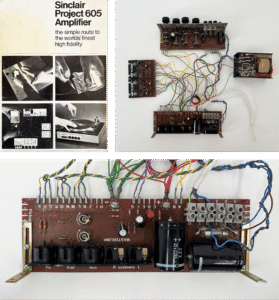
The Project 605 was a complete ready-packaged version of the earlier Project 60 hi-fi system. It combined two Z30 amplifiers, a Stereo Sixty pre-amp, a PZ5 power supply, and a new “Masterlink” unit that handled all the connections. Pre-cut leads and clip-on fittings removed the need for soldering, while a comprehensive manual guided assembly. Owners were told they could expand their setup with forthcoming Project 60 modules designed for the same plug-together method, making the 605 both accessible and adaptable for home hi-fi enthusiasts during a period of growing competition in the audio market.
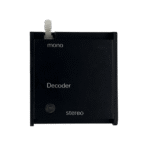
Part of the modular Project 80 hi-fi range, this unit converted FM radio signals into two separate channels, creating stereo sound. It featured a mono/stereo switch, LED indicator, and compact casing for flexible setup. Designed with clarity and function in mind, it was awarded a 1974 iF Design Award—an international prize recognising excellence in product design.
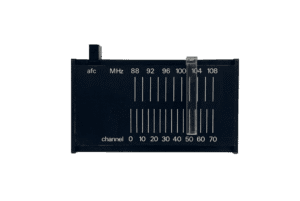
This FM tuner introduced radio capability to Sinclair’s modular Project 80 audio system. It featured dual varicap tuning—a technology that electronically adjusted radio frequencies without bulky mechanical components—and automatic frequency control (AFC) for more stable reception. Its compact, stylish design received international recognition through the prestigious iF Design Award. Intended for easy pairing with other Project 80 units, it catered to growing demand for customisable, space-efficient home audio equipment.
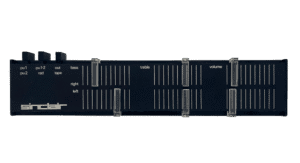
The control centre of the Project 80 system, this pre-amplifier allowed users to adjust volume, tone, and balance before passing sound to a power amplifier. Compact and intuitively laid out, it supported standard stereo signals and mirrored the minimalist aesthetic of the wider range. As with other components in the series, its design received the iF Design Award for combining style and practicality in home electronics.
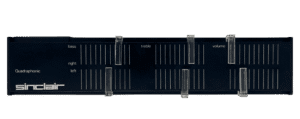
This quadraphonic pre-amplifier was the advanced control centre of the Project 80 system, designed to handle four separate audio channels for an early home surround sound experience. It allowed users to adjust bass, treble, volume, and balance across four speakers—front and rear—offering a richer, more immersive audio environment than the standard stereo model. Its black anodised aluminium front and distinctive slider controls marked a move away from Sinclair’s earlier Project 60 design.
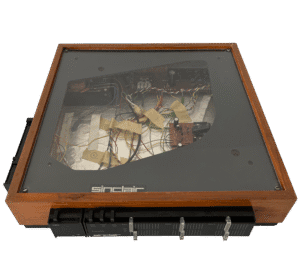
The Project 805 was a complete stereo hi-fi kit derived from the Project 80 modular system. Its distinctive feature was the “Masterlink” unit, unique to the 605 and 805 kits, which simplified all connections between modules. Two Z40 amplifiers, a preamplifier, and a PZ5 power supply were supplied, with pre-cut wires and push-fit connectors that avoided soldering. Assembly for this kit was guided by the Project 80 manual. This assembled example is housed in a wooden case with a glass top, highlighting the inner circuitry and making the technology visible, while also presenting the kit as an attractive piece that could sit comfortably in a user’s home.
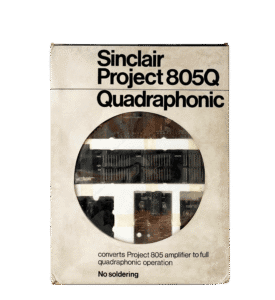
This all-in-one quadraphonic kit introduced early surround sound into the home. Part of Sinclair’s Project 80 range, the SQ 805Q used the SQ matrix format—an encoding system developed by CBS and Sony—to turn standard stereo recordings into four-channel sound with front and rear channels. Sold as a do-it-yourself kit, it included decoder, amplifiers, a power supply, and quadraphonic control unit—making immersive audio both innovative and accessible to domestic listeners.
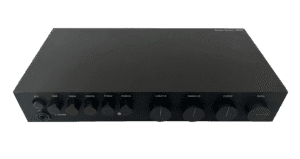
This black stereo amplifier was the last in Sinclair’s hi-fi series. It delivered 17 watts per channel with very low distortion, helping preserve sound clarity even at higher volumes. Sold with a matching FM tuner, it was aimed at budget-conscious listeners seeking high-quality audio. Reviewers praised its performance—often mistaking it for a more powerful unit—but also noted inconsistent build quality, reflecting the challenges of Sinclair’s shift toward mass production.
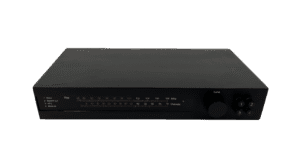
Designed to complete the System 4000, this FM tuner matched the amplifier in both styling and scale. It let users tune into stereo radio with ease, forming a sleek two-unit setup for the home. Marketed as “handsome, elegant style… good value,” it reflected the company’s focus on delivering attractive, affordable audio technology. Though the system never became a major hit, it marked the end of Sinclair Radionics’ hi-fi ambitions.
